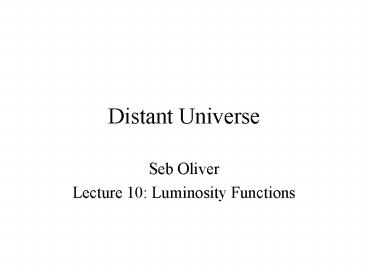Seb Oliver - PowerPoint PPT Presentation
1 / 30
Title: Seb Oliver
1
Distant Universe
- Seb Oliver
- Lecture 10 Luminosity Functions
2
Main Topics
- Standard Hot Big Bang Model
- Classical Observational Cosmology
- Galaxy Evolution
- The Hunt for the First Galaxies
- Background Light
- Structure Formation
3
Galaxy Evolution
- K-Corrections
- Luminosity Functions
- V/Vmax test of Evolution
- Passive Stellar Evolution
- Number Counts
- The Global History of Star-Formation
4
The Luminosity Functions
- To study galaxy evolution we need to compare
galaxies today with galaxies in the past - To perform a fair comparison we need to compare
the emitted power at the same wavelengths, hence
K-corrections (Lect. 9) - We cannot observe the same galaxy at different
times, so we must look at the statistical
properties of galaxies as populations, hence we
study luminosity functions
5
Luminosity Functions
The luminosity function characterises the number
density of galaxies as a function of the
luminosity Ln
Luminosity function, usually written ?(L), is
defined as the co-moving number density (number
of objects per co-moving volume) in some range of
luminosity (usually logarithmic)
6
Luminosity Functions1/VA Estimator
Object Too Faint
Given a single object, X, visible within some
volume, VA
Object Detectable
For a number of objects i
Too Big
This 1/VA estimator is a maximum likelihood
estimator
7
Luminosity Functions1/VA Estimator
8
Luminosity Functions1/VA Estimator zmax
Observe fn and z over some area ?2 down to some
flux density limit, fn,min
can be estimated for different galaxy types
using T for type and L for cosmology
calculated numerically
9
Luminosity Functions1/VA Estimator Vmax
Assume for simplicity that the zmax is constant
across the survey area, and that the survey is
only limited at zmax i.e. zmin0, though
generalisations not difficult
co-moving volume
Matter dominated
10
Luminosity Functions
- Luminosity functions are different and should be
estimated separately for different - Galaxy Types
- Ellipticals
- Spirals
- AGNs
- Dwarfs
- Emission Wavelengths
- ?-/X-ray through radio
- Environments
- Clusters
- Field
- Redshifts
- Evolution
11
Normal galaxy Types
12
EnvironmentCluster
13
Environment Field
14
Luminosity Functions
- In order to allow easy comparison between
different determinations of luminosity functions
and luminosity functions of different types it is
usual to use simple parameterisations - Schecter - common for galaxies
- Two-Power-Law - common for AGN
- Power - Law with exponential cut-off - infrared
galaxies
15
Luminosity Functions
- Schecter Function - common for galaxies
Exponential Cut-off
16
Luminosity Functions
17
SDSS Luminosity Function
Blanton et al. 2001 AJ 121, 2358
www.sdss.org
18
SDSS Luminosity Function
Blanton et al. 2001 AJ 121, 2358
19
Parametric Evolution of Luminosity Functions
Pure density evolution
Density Evolution
Luminosity Evolution
Pure Luminosity evolution
20
Parametric Evolution of Luminosity Functions
typical estimate of
21
IR Evolution of AGN (ELAIS)
Matute et al. 2002 MNRAS 332 11
22
Luminosity Function from 2dF Quasar Survey
www.2dfquasar.org
23
Luminosity Function from 2dF Quasar Survey
24
Luminosity Function from 2dF Quasar Survey
25
Luminosity Function from 2dF Quasar Survey
26
V/Vmax Evolution Test
For objects of fixed luminosity, L, in a redshift
survey there is a maximum volume in which the
object could have been seen, Vmax(zmax)
We can compare this to the volume in which the
object actually was seen V(z)
Thus V could be between 0 and Vmax
27
V/Vmax Evolution Test
If there was no change in co-moving number density
Since the number density does not change the
probability of an object appearing in a survey
volume V, P(ltV)
dP is probability in range V to VdV
i.e. constant (independent of V) thus V/Vmax
distributed uniformly between 0 and 1 thus
ltV/Vmaxgt is 0.5
28
V/Vmax Evolution Test
For a real survey with n galaxies our estimate of
ltV/Vmaxgt has some uncertainty associated with it
and it can be shown that in the absence of
evolution
Thus a measured value of ltV/Vmaxgt that differed
significantly from 0.5 demonstrates that
evolution has occurred
galaxies more numerous in past
galaxies less numerous in past
29
Expected Evolution from SWIRE
30
AGN Galaxy Connection
- MBH ? Mspheroid
- (Magorrian)
- Both evolve strongly
- closer connections at higher z ?
- Strong SED evolution for LIRGs ULIRGs?
Tyson

